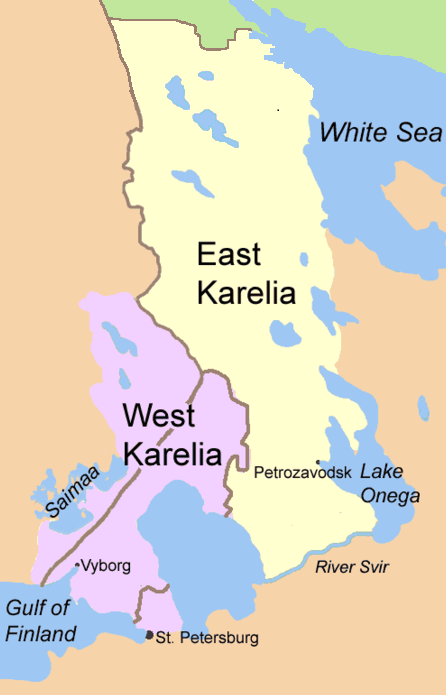|
Forest Guerrillas
Forest Guerrillas ( fi, Metsäsissit) was a Finnic resistance movement formed by some of the inhabitants of the parishes of Repola and Porajärvi, in addition to several White Guard volunteers after their territory was ceded to Bolshevist Russia in the Treaty of Tartu of 1920. The conflict is known as the East Karelian Uprising. The 2,000 ''metsäsissi'' forces managed to capture large parts of East Karelia during their rebellion against their Russian rulers in 1921, aiming to unite these areas with the newly formed Republic of Finland. Ultimately, however, in 1922 the rebel forces withdrew into Finland. See also * Forest Brothers * Leśni * Heimosodat The Finnish Heimosodat (singular ''heimosota''), refer to a series of armed conflicts and private military expeditions in 1918–1922 into the areas of the former Russian Empire which were neighbouring Finland and inhabited in large part by ot ... Finnish Civil War History of Karelia Military history of the Soviet Uni ... [...More Info...] [...Related Items...] OR: [Wikipedia] [Google] [Baidu] |
Paramilitary
A paramilitary is an organization whose structure, tactics, training, subculture, and (often) function are similar to those of a professional military, but is not part of a country's official or legitimate armed forces. Paramilitary units carry out duties that a country's military or police forces are unable or unwilling to handle. Other organizations may be considered paramilitaries by structure alone, despite being unarmed or lacking a combat role. Overview Though a paramilitary is, by definition, not a military, it is usually equivalent to a light infantry force in terms of strength, firepower, and organizational structure. Paramilitaries use "military" equipment (such as long guns and armored personnel carriers; usually military surplus resources), skills (such as battlefield medicine and bomb disposal), and tactics (such as urban warfare and close-quarters combat) that are compatible with their purpose, often combining them with skills from other relevant fields such a ... [...More Info...] [...Related Items...] OR: [Wikipedia] [Google] [Baidu] |
East Karelia
East Karelia ( fi, Itä-Karjala, Karelian: ''Idä-Karjala''), also rendered as Eastern Karelia or Russian Karelia, is a name for the part of Karelia that since the Treaty of Stolbova in 1617 has remained Eastern Orthodox under Russian supremacy. It is separate from the western part of Karelia, called ''Finnish Karelia'' or historically ''Swedish Karelia'' (before 1808). Most of East Karelia has become part of the Republic of Karelia within the Russian Federation. It consists mainly of the old historical regions of Viena and Aunus. Culture and ideology 19th-century ethnic-nationalist Fennomans saw East Karelia as the ancient home of Finnic culture, "un-contaminated" by either Scandinavians or Slavs. In the sparsely-populated East Karelian backwoods, mainly in White Karelia, Elias Lönnrot (1802–1884) collected the folk tales that ultimately would become Finland's national epic, the Kalevala (published from 1835 to 1849). The idea of annexing East Karelia to Finland as ... [...More Info...] [...Related Items...] OR: [Wikipedia] [Google] [Baidu] |
Paramilitary Organisations Based In Finland
A paramilitary is an organization whose structure, tactics, training, subculture, and (often) function are similar to those of a professional military, but is not part of a country's official or legitimate armed forces. Paramilitary units carry out duties that a country's military or police forces are unable or unwilling to handle. Other organizations may be considered paramilitaries by structure alone, despite being unarmed or lacking a combat role. Overview Though a paramilitary is, by definition, not a military, it is usually equivalent to a light infantry force in terms of strength, firepower, and organizational structure. Paramilitaries use "military" equipment (such as long guns and armored personnel carriers; usually military surplus resources), skills (such as battlefield medicine and bomb disposal), and tactics (such as urban warfare and close-quarters combat) that are compatible with their purpose, often combining them with skills from other relevant fields such a ... [...More Info...] [...Related Items...] OR: [Wikipedia] [Google] [Baidu] |
Military Units And Formations Of The Russian Civil War
A military, also known collectively as armed forces, is a heavily armed, highly organized force primarily intended for warfare. It is typically authorized and maintained by a sovereign state, with its members identifiable by their distinct military uniform. It may consist of one or more military branches such as an army, navy, air force, space force, marines, or coast guard. The main task of the military is usually defined as defence of the state and its interests against external armed threats. In broad usage, the terms ''armed forces'' and ''military'' are often treated as synonymous, although in technical usage a distinction is sometimes made in which a country's armed forces may include both its military and other paramilitary forces. There are various forms of irregular military forces, not belonging to a recognized state; though they share many attributes with regular military forces, they are less often referred to as simply ''military''. A nation's military may f ... [...More Info...] [...Related Items...] OR: [Wikipedia] [Google] [Baidu] |


